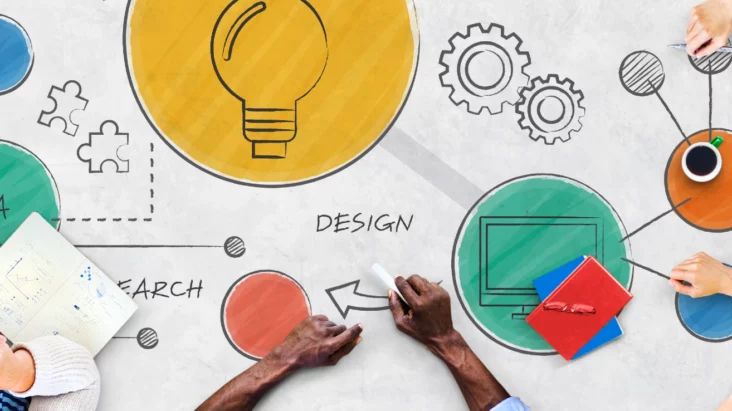In brief:
Ever feel like you’re swimming in a sea of product options and don’t know where to start? It can be tough to figure out what product to build next, especially if your company is growing fast. That’s where a product roadmap comes in. A product roadmap lays out all the products and features currently in development, as well as the ones planned for the future. It can help you stay focused on your priorities and avoid feature overload. But not everyone needs a roadmap… read on to find out if one is right for you!
Table of content:
What is a product roadmap and what does it include
A product roadmap is a document that provides an overview of the planned development for a product. It typically includes a timeline and various milestones that need to be reached in order for the product to be successful. The roadmap also contains information about the features that will be included in each release, as well as any dependencies that need to be taken into account. In some cases, the roadmap may also include information about how the product will be marketed and what sales goals need to be met. Ultimately, the goal of a product roadmap is to provide clarity and direction for all team members involved in the development process.
Features
A feature in a product roadmap is an element or function of a product that is planned for development. It can be something as small as a new button or as large as a completely revamped interface. Features are usually displayed in a product roadmap in one of two ways: as a list or as a chart. A list will simply show a brief description of each feature, along with its associated release date (if applicable). A chart, on the other hand, will provide more detail about each feature, including its priority level and how it relates to other features in the roadmap.
Dependencies
Dependencies are used in a product roadmap to illustrate how different features are interconnected. They can also be used to indicate which features are more important than others. This can include things like dependencies on other products or dependencies on specific team members. For example, if your company is developing a new mobile app, you may need to wait for the release of the latest version of the iOS operating system before you can start development. This would be considered a dependency.
Dependencies are usually displayed in a product roadmap as lines connecting different features. The line will be thicker if the dependency is stronger, and it may also have an arrow indicating the direction of the dependency (i.e., which feature is dependent on which).
Timeline
The timeline in a product roadmap shows the planned development schedule for a product. It can be displayed as a list of milestones or as a more detailed chart. The timeline may also include information about when each release is scheduled to occur. In some cases, the timeline may span multiple years into the future.
Milestones
A milestone in a product roadmap is an important event or achievement that needs to be reached in order for the product to be successful. It can be something as small as finishing the development of a particular feature or as large as launching the product to the public. Milestones are usually displayed in a product roadmap as a list, with each item including a brief description and an associated date. In some cases, milestones may also be represented by icons or other visual indicators.
Why do you need a product roadmap?
If a product roadmap isn’t used, it can be difficult to keep track of all the products and features that are in development. This can lead to feature overload and a lack of focus on priorities. Feature overload can occur when there are too many features in development at once, which can lead to a lack of focus on priorities. This can be harmful to the development process, as it can delay the release of important features and cause frustration among team members.
A lack of focus on priorities can also be harmful to a product. If team members are not clear on what the most important features are, they may spend too much time working on less important features. This can lead to a delay in the release of the product, as well as a loss of interest from potential customers. In addition, it can be difficult to coordinate development efforts between different team members if there is no clear plan for what needs to be done.
Some real-world examples of feature overload and a lack of focus on priorities include:
-The development of a new mobile app that is delayed due to the inclusion of too many features
-A team working on a website redesign that spends too much time on less important details, leading to a delay in the launch
-The development of a new software product that is hindered by scope creep, as more and more features are added without any clear plan or priority list
A product roadmap can help to avoid these problems by providing a clear overview of the planned development of a product. It can also help to keep team members focused on the most important tasks, as well as provide a way to track progress and identify any potential risks. In addition, a product roadmap can be used to communicate the development plan to stakeholders and potential customers.
How can you create a product roadmap for your business
Ok so you’ve just been tasked with creating a product roadmap for your company, but you’re not sure where to start. A product roadmap can be a daunting task if you don’t know where to start. There are so many things to consider, and it’s easy to feel overwhelmed.
The best way to get started is by breaking the process down into smaller chunks. First, you need to determine what the goal of the product is and then figure out what needs to be done in order to achieve that goal. Once you have a clear picture of what needs to be done, you can create a timeline and begin outlining specific milestones. Finally, once all of the details have been finalised, you can create a draft of the product roadmap document.
Determining the goal of your product
The goal of a product is what you are trying to achieve with the product. It may be something as simple as making a profit or as complex as improving customer satisfaction. Whatever the goal may be, it needs to be clear and concise. You can often find the product goal by looking at the product vision and mission statement and we discussed how to create these in our previous blog title What is a Product Vision Statement? How to Write One That Inspires Your Team.
Figuring out what needs to be done
Once you have determined the goal of your product, you can begin outlining the steps needed to achieve that goal, we can call these the features and milestones. In order to figure out what needs to be done, you need to work with other people who know about the product. This includes people who are working on developing the product and people who are using it.
– Business owners/Managers
– Developers/Engineers/Designers
– Users/Customers
This will help to ensure that your product roadmap is focused and that all team members are working towards the same objectives.
Creating a timeline
Once you have determined the goal of your product and outlined the steps needed to achieve it, you can create a timeline for the development process. The timeline should list each step in the development process and the associated date. In some cases, it may also be necessary to include information about when each release is scheduled to occur.
The timeline is an important part of the product roadmap because it provides a visual representation of the development process. This can help team members to better understand how different features are interconnected and how they fit into the overall plan.
Drafting the product roadmap
After you know what the goal of the product is, what needs to be done to achieve it, and when everything needs to happen, you can make a document with all of that information called a “product roadmap.” This will help other people who work on the product know what needs to be done and when, so everyone can stay focused and on track
What are some common pitfalls to avoid when creating a product roadmap
When creating a product roadmap, it’s important to avoid common pitfalls so that you can ensure that the roadmap is effective and accurate. Here are a few things to keep in mind:
1. Don’t try to do too much. It’s important to focus on priorities and make sure that the roadmap stays manageable. Trying to include too many features or objectives will only make the process more difficult and lead to confusion.
2. Keep it simple. The product roadmap should be easy to understand and use. Avoid using jargon or technical terms that people may not be familiar with.
3. Be realistic. It’s important to set realistic goals and timelines when creating a product roadmap. Otherwise, team members will become frustrated and demotivated.
4. Be flexible. The product roadmap is a living document that should be updated as the development process progresses. Be prepared to make changes to the roadmap as new information arises.
5. Get feedback. Before finalising the product roadmap, be sure to get feedback from other team members and stakeholders. This will help to ensure that the roadmap is accurate and relevant.
Product roadmaps are an essential tool for any product development team. By following these tips, you can create a roadmap that will help to keep your team on track and focused on the right objectives.
How can you use your product roadmap to improve your business?
Improve communication between team members.
One of the main benefits of using a product roadmap is that it can help to improve communication between team members. The roadmap can help to improve communication between team members by providing a visual overview of the development process. This can help team members to better understand each other’s roles and responsibilities, as well as the overall plan for the product. By keeping everyone on the same page, the roadmap can help to improve collaboration and prevent misunderstandings.
Track progress and identify areas of focus
Additionally, the product roadmap can be used to track progress and identify areas where more focus is needed. For example, identifying which milestones have been reached and which still need to be achieved. This information can be used to prioritise different areas of development and ensure that the team is focused on the right objectives. Additionally, the product roadmap can help identify areas where more focus is needed in order to meet the objectives. This can help to improve the efficiency of the development process and ensure that objectives are being met.
Assess risks and identify potential problems
Finally, the product roadmap can be used as a tool to assess risks and identify potential problems. By identifying risks early on, you can make sure that they are addressed before they become major issues.
In conclusion:
A product roadmap is a document that provides an overview of the planned development of a product. It typically includes a timeline and various milestones that need to be reached in order for the product to be successful. The roadmap also contains information about the features that will be included in each release, as well as any dependencies that need to be taken into account. If a product roadmap isn’t used, it can be difficult to keep track of all the products and features that are in development. This can lead to feature overload and a lack of focus on priorities. Have you created a product roadmap for your business? If not, we encourage you to give it a try! and if you have why not share your experience in the comments below!
Reference Sources
- None








